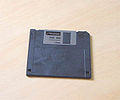Digital camera: Difference between revisions
No edit summary Tag: Mobile edit |
No edit summary |
||
| Line 344: | Line 344: | ||
[[Category:Digital cameras| ]] |
[[Category:Digital cameras| ]] |
||
[[Category:1975 introductions]] |
[[Category:1975 introductions]] |
||
Hi. |
|||
Revision as of 19:00, 5 December 2013
This article has multiple issues. Please help improve it or discuss these issues on the talk page. (Learn how and when to remove these template messages)
|

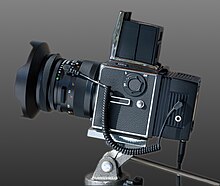
A digital camera (or digicam) is a camera that encodes digital images and videos digitally and stores them for later reproduction.[1] Most cameras sold today are digital,[2] and digital cameras are incorporated into many devices ranging from PDAs and mobile phones (called camera phones) to vehicles.
Digital and film cameras share an optical system, typically using a lens with a variable diaphragm to focus light onto an image pickup device.[3] The diaphragm and shutter admit the correct amount of light to the imager, just as with film but the image pickup device is electronic rather than chemical. However, unlike film cameras, digital cameras can display images on a screen immediately after being recorded, and store and delete images from memory. Many digital cameras can also record moving video with sound. Some digital cameras can crop and stitch pictures and perform other elementary image editing.
History
Steven Sasson as an engineer at Eastman Kodak invented and built the first electronic camera using a charge-coupled device image sensor in 1975.[4] Earlier ones used a camera tube; later ones digitized the signal. Early uses were mainly military and scientific; followed by medical and news applications. In the mid to late 1990s digital cameras became common among consumers. By the mid-2000s digital cameras had largely replaced film cameras, and higher-end cell phones had an integrated digital camera. By the beginning of the 2010s smartphones had an integrated digital camera.
Image sensors
Image resolution
The resolution of a digital camera is often limited by the image sensor [5] (typically a CCD or CMOS sensor chip) that turns light into discrete signals. The sensor is made up of millions of "buckets". The brighter the image at a given point on the sensor, the larger the value that is read for that pixel. Depending on the physical structure of the sensor, a color filter array may be used which requires a demosaicing. The number of resulting pixels in the image determines its "pixel count". The pixel count is the product of the row and the column. For example, a 1,000x1,000 image would have 1,000,000 pixels.
Methods of image capture


Since the first digital backs were introduced, there have been three main methods of capturing the image, each based on the hardware configuration of the sensor and color filters.
single-shot capture systems use either one sensor chip with a Bayer filter mosaic, or three separate image sensors (one each for the primary additive colors red, green, and blue) which are exposed to the same image via a beam splitter.
multi-shot exposes the sensor to the image in a sequence of three or more openings of the lens aperture. There are several methods of application of the multi-shot technique. The most common originally was to use a single image sensor with three filters passed in front of the sensor in sequence to obtain the additive color information. Another multiple shot method is called Microscanning. This method uses a single sensor chip with a Bayer filter and physically moved the sensor on the focus plane of the lens to construct a higher resolution image than the native resolution of the chip. A third version combined the two methods without a Bayer filter on the chip.
The third method is called scanning because the sensor moves across the focal plane much like the sensor of an image scanner. Their linear or tri-linear sensors utilize only a single line of photosensors, or three lines for the three colors. Scanning may be accomplished by moving the sensor e.g. when using color co-site sampling or rotating the whole camera; a digital rotating line camera offers images of very high total resolution.
The choice of method for a given capture is determined largely by the subject matter. It is usually inappropriate to attempt to capture a subject that moves with anything but a single-shot system. However, the higher color fidelity and larger file sizes and resolutions available with multi-shot and scanning backs make them attractive for commercial photographers working with stationary subjects and large-format photographs.[original research?]
Improvements in single-shot cameras and image file processing at the beginning of the 21st century made single shot cameras almost completely dominant, even in high-end commercial photography.
Filter mosaics, interpolation, and aliasing
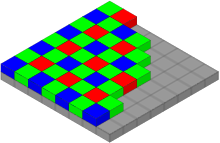
Most current consumer digital cameras use a Bayer filter mosaic in combination with an optical anti-aliasing filter to reduce the aliasing due to the reduced sampling of the different primary-color images. A demosaicing algorithm is used to interpolate color information to create a full array of RGB image data.
Cameras that use a beam-splitter single-shot 3CCD approach, three-filter multi-shot approach, color co-site sampling or Foveon X3 sensor do not use anti-aliasing filters, nor demosaicing.
Firmware in the camera, or a software in a raw converter program such as Adobe Camera Raw, interprets the raw data from the sensor to obtain a full color image, because the RGB color model requires three intensity values for each pixel: one each for the red, green, and blue (other color models, when used, also require three or more values per pixel). A single sensor element cannot simultaneously record these three intensities, and so a color filter array (CFA) must be used to selectively filter a particular color for each pixel.
The Bayer filter pattern is a repeating 2×2 mosaic pattern of light filters, with green ones at opposite corners and red and blue in the other two positions. The high proportion of green takes advantage of properties of the human visual system, which determines brightness mostly from green and is far more sensitive to brightness than to hue or saturation. Sometimes a 4-color filter pattern is used, often involving two different hues of green. This provides potentially more accurate color, but requires a slightly more complicated interpolation process.
The color intensity values not captured for each pixel can be interpolated from the values of adjacent pixels which represent the color being calculated.
Sensor size and angle of view
Cameras with digital image sensors that are smaller than the typical 35mm film size have a smaller field or angle of view when used with a lens of the same focal length. This is because angle of view is a function of both focal length and the sensor or film size used.
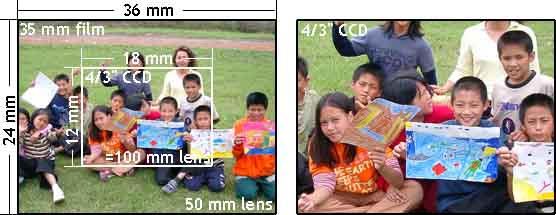
The crop factor is relative to the 35mm film format. If a smaller sensor is used, as in most digicams, the field of view is cropped by the sensor to smaller than the 35mm full-frame format's field of view. This narrowing of the field of view may be described as crop factor, a factor by which a longer focal length lens would be needed to get the same field of view on a 35mm film camera.
The result is geometrically similar to taking the image from the film camera and cutting it down (cropping) to the size of the sensor. The amount of information captured is dependent on sensor density[citation needed]
For example, a camera with a 1/1.8-inch sensor has a 5.0x field of view crop. When it is mated with a 5-50mm zoom lens, it produces an image with field of view similar to those produced by a 35mm film camera with a 25–250mm lens. The smaller sensor reduces the captured field of view.
Methods of compensating for this or otherwise producing wider digital photographs include using a fisheye lens and "defishing" the image in post processing to simulate a rectilinear wide angle lens.
Full-frame digital SLRs utilize a sensor of the same size as a frame of 35mm film. Some examples of cameras are Canon 1D X, 1Ds and 5D series, and 6D; Kodak Pro DCS-14n; Nikon D3, D4, D600, D700 and D800 lines; and Contax N Digital.
Common values for field of view crop in DSLRs using active pixel sensors include 1.3x for some Canon (APS-H) sensors, 1.5x for Sony APS-C sensors used by Nikon, Pentax and Konica Minolta and for Fujifilm sensors, 1.6 (APS-C) for most Canon sensors, ~1.7x for Sigma's Foveon sensors and 2x for Kodak and Panasonic 4/3-inch sensors currently used by Olympus and Panasonic. Crop factors for non-SLR consumer compact and bridge cameras are larger, frequently 4x or more.
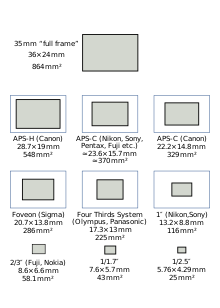
| Table of sensor sizes[6] | ||||||||||||||
|---|---|---|---|---|---|---|---|---|---|---|---|---|---|---|
| Type | Width (mm) | Height (mm) | Size (mm²) | |||||||||||
| 1/3.6" | 4.00 | 3.00 | 12.0 | |||||||||||
| 1/3.2" | 4.54 | 3.42 | 15.5 | |||||||||||
| 1/3" | 4.80 | 3.60 | 17.3 | |||||||||||
| 1/2.7" | 5.37 | 4.04 | 21.7 | |||||||||||
| 1/2.5" | 5.76 | 4.29 | 24.7 | |||||||||||
| 1/2.3" | 6.16 | 4.62 | 28.5 | |||||||||||
| 1/2" | 6.40 | 4.80 | 30.7 | |||||||||||
| 1/1.8" | 7.18 | 5.32 | 38.2 | |||||||||||
| 1/1.7" | 7.60 | 5.70 | 43.3 | |||||||||||
| 2/3" | 8.80 | 6.60 | 58.1 | |||||||||||
| 1" | 12.8 | 9.6 | 123 | |||||||||||
| 4/3" | 18.0 | 13.5 | 243 | |||||||||||
| APS-C | 25.1 | 16.7 | 419 | |||||||||||
| 35 mm | 36 | 24 | 864 | |||||||||||
| Back | 48 | 36 | 1728 | |||||||||||

Types of digital cameras
Digital cameras come in a wide range of sizes, prices and capabilities. Specialized cameras including multispectral imaging equipment and astrographs are used in scientific, military, medical and other special purposes for which digital photography was invented.
Compact digital cameras


Compact cameras are intended to be portable and are particularly suitable for casual "snapshot".
Most[according to whom?], apart from ruggedized or water-resistant models, incorporate a retractable lens assembly that provides optical zoom. The auto actuating lens cover protects the lens from elements.
Compact[by whom?] cameras are usually designed to be easy to use, sacrificing advanced features and picture quality for compactness and simplicity; images can usually only be stored using lossy compression (JPEG). Most have a built-in flash usually of low power, sufficient for nearby subjects. Live preview is almost always used to frame the photo. Most have limited motion picture capability. Compacts often have macro capability and zoom lenses but the zoom range is usually less than for bridge and DSLR cameras. Generally a contrast-detect autofocus system, using the image data from the live preview feed of the main imager, focuses the lens.
Typically, these cameras incorporate a nearly silent leaf shutter into the lens but play a simulated camera sound [7] for skeuomorphic purposes.
For low cost and small size, these cameras typically use image sensor formats with a diagonal between 6 and 11 mm, corresponding to a crop factor between 7 and 4. This gives them weaker low-light performance, greater depth of field, generally closer focusing ability, and smaller components than cameras using larger sensors. Some cameras use a larger sensor including, at the high end, a full-frame sensor.
Some cameras have GPS, compass, barometer and altimeter.[8] and some are rugged and waterproof.
Starting in 2011, some compact digital cameras can take 3D still photos. These 3D compact stereo cameras can capture 3D panoramic photos for play back on a 3D TV.
In 2013, Sony released two add-on camera models without display, to be used with a smartphone or tablet, controlled by a mobile application via WiFi.[9]
Bridge cameras
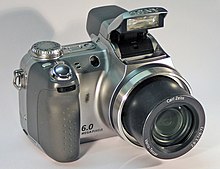
Bridge are higher-end digital cameras that physically resemble DSLRs and share with them some advanced features, but share with compacts the use of a fixed lens and a small sensor. Like compacts, most use live preview to frame the image. Their autofocus uses the same contrast-detect mechanism, but many bridge cameras have a manual focus mode, in some cases using a separate focus ring, for greater control.
Due to the combination of big physical size but a small sensor, many of these cameras have a large zoom range and a wide aperture. This type of cameras generally include an image stabilization system to enable longer handheld exposures.
Bridge cameras are usually fitted with fixed (non-interchangeable) lenses. Some have a lens thread to attach an accessory wide-angle or telephoto converters), The scene is composed by viewing the display or the electronic viewfinder (EVF). Most have a longer shutter lag than a DSLR. Many of these cameras can store images in a raw image format, or processed and JPEG compressed, or both. The majority have a built-in flash.
In bright sun, the quality difference between a good compact camera and a digital SLR is minimal but bridge cameras are more portable, cost less and have a similar zoom ability to DSLR. Thus a bridge camera may better suit outdoor daytime activities, except when seeking professional-quality photos.[10]
A 3D photo mode was introduced in 2011, whereby the camera automatically takes a second image from a slightly different perspective and provides a standard MPO file for stereo display.[11]
Mirrorless interchangeable-lens camera
In late 2008, a new type of camera emerged, which uses larger sensors and offers lens interchangeability. These are simpler and more compact than DSLRs as they do not have the lens reflex system. Some use Micro Four Thirds and some use APS-C such as the Sony NEX series, Pentax K-01, and Canon EOS M
Digital single-lens reflex cameras

Digital single-lens reflex cameras (DSLR) use a mirror to direct light from the lens through a separate optical viewfinder. The mirror is moved out of the way to direct the image to the sensor at the time of exposure.[citation needed]
Autofocus is accomplished using sensors in the mirror box. Some DSLRs have a "live view" mode that allows framing using the screen with image from the sensor.
These cameras have much larger sensors than the other types, typically 18 mm to 36 mm on the diagonal (crop factor 2, 1.6, or 1). This gives them superior low-light performance, less depth of field at a given aperture, and a larger size.
They make use of interchangeable lenses to allow use of different lenses. Some lenses are made for digital SLR use only.
Digital rangefinders
A rangefinder is a user-operated optical mechanism to measure subject distance. Most digital cameras measure subject distance automatically using electro-optical techniques, but it is not customary to say that they have a rangefinder.
Line-scan camera systems
A line-scan camera has a single row of pixel sensors, instead of a matrix of them. The frames are continuously fed to a computer that joins them to each other and makes an image. This makes possible sharp pictures of objects that have passed the camera at high speed. Sporting races commonly use this kind of camera to make photo finishes, i.e. determine the winner when multiple competitors cross the finishing line at nearly the same time. These cameras can also be used as industrial instruments for analyzing fast processes.
Integration
Many devices have a built-in digital camera. For example, mobile phones, PDAs and laptop computers. Built-in cameras generally store the images in JPEG file format.
Mobile phones incorporating digital cameras were introduced in Japan in 2001 by J-Phone. In 2003 camera phones outsold stand-alone digital cameras, and in 2006 they outsold film and digital stand-alone cameras. Five billion camera phones were sold in five years, and by 2007 more than half of the installed base of all mobile phones were camera phones. Sales of separate cameras peaked in 2008.[12]
Waterproof
Waterproof digital cameras include those that can be totally submerged for underwater photography and those designed to operate in wet conditions on land. Many waterproof digital cameras are shockproof and resistant to low temperatures. Waterproof housings are available to protect non-waterproof cameras in wet or submerged conditions.
Recent trends
Sales of traditional digital cameras have declined due to the increasing use of smartphones for casual photography, which also enable easier manipulation and sharing of photos through the use of apps and web-based services. "Bridge cameras", in contrast, have held their ground with functionality that most smartphone cameras lack, such as optical zoom and other advanced features.[13][14] DSLRs have also lost ground to Mirrorless interchangeable-lens camera (MILC)s offering the same sensor size in a smaller camera. A few expensive ones use a full-frame sensor as DSLR professional cameras.[15]
In response to the convenience and flexibility of smartphone cameras, some manufacturers produced "smart" digital cameras that combine features of traditional cameras with those of a smartphone. In 2012, Nikon and Samsung released the Coolpix S800c and Galaxy Camera, the first two digital cameras to run the Android operating system. Since this software platform is used in many smartphones, they can integrate with services (such as e-mail attachments, social networks and photo sharing sites) as smartphones do, and use other Android-compatible software as well.[13]
In an inversion, some phone makers have introduced smartphones with cameras designed to resemble traditional digital cameras. Nokia released the 808 PureView and Lumia 1020 in 2012 and 2013; the two devices respectively run the Symbian and Windows Phone operating systems, and both include a 41-megapixel camera with 6x optical zoom (along with a camera grip attachment for the latter).[16] Similarly, Samsung introduced the Galaxy S4 Zoom, a device with 16-megapixel camera and 10x optical zoom, combining traits from the Galaxy S4 with the Galaxy Camera.[17]
Light-field cameras were introduced in 2013 with one consumer product and several professional ones.
Connectivity
Transferring photos
Many digital cameras can connect directly to a computer to transfer data:
- Early cameras used the PC serial port. USB is now the most widely used method (most cameras are viewable as USB mass storage), though some have a FireWire port. Some cameras use USB PTP mode for connection instead of USB MSC; some offer both modes.
- Other cameras use wireless connections, via Bluetooth or IEEE 802.11 Wi-Fi, such as the Kodak EasyShare One.
- Cameraphones and some high-end stand-alone digital cameras also use cellular networks to connect for sharing images. The most common standard on cellular networks is the MMS Multimedia Messaging Service, commonly called "picture messaging". The second method with smartphones is to send a picture as an email attachment. Many cameraphones do not support email, so this is less common.
A common alternative is the use of a card reader which may be capable of reading several types of storage media, as well as high speed transfer of data to the computer. Use of a card reader also avoids draining the camera battery during the download process. An external card reader allows convenient direct access to the images on a collection of storage media. But if only one storage card is in use, moving it back and forth between the camera and the reader can be inconvenient. Many computers have a card reader built in, at least for SD cards.
Printing photos
Many modern cameras support the PictBridge standard, which allows them to send data directly to a PictBridge-capable computer printer without the need for a computer.
Wireless connectivity can also provide for printing photos without a cable connection.
Polaroid has introduced a printer integrated into its digital camera which creates a small, printed copy of a photo. This is reminiscent of the original instant camera, popularized by Polaroid in 1975.[18]
Displaying photos
Many digital cameras include a video output port. Usually sVideo, it sends a standard-definition video signal to a television, allowing the user to show one picture at a time. Buttons or menus on the camera allow the user to select the photo, advance from one to another, or automatically send a "slide show" to the TV.
HDMI has been adopted by many high-end digital camera makers, to show photos in their high-resolution quality on an HDTV.
In January 2008, Silicon Image announced a new technology for sending video from mobile devices to a television in digital form. MHL sends pictures as a video stream, up to 1080p resolution, and is compatible with HDMI.[19]
Some DVD recorders and television sets can read memory cards used in cameras; alternatively several types of flash card readers have TV output capability.
Modes
Many digital cameras have preset modes for different applications. Within the constraints of correct exposure various parameters can be changed, including exposure, aperture, focusing, light metering, white balance, and equivalent sensitivity. For example a portrait might use a wider aperture to render the background out of focus, and would seek out and focus on a human face rather than other image content.
Image data storage
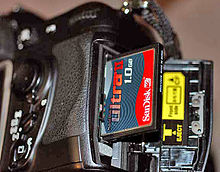
Many camera phones and most stand alone digital cameras use removable flash memory memory card to store image data. The majority of cards for separate cameras are SD format; some are CompactFlash in addition to other types. In January 2012, a faster XQD card format was announced.[20]
A few cameras use some other form of removable storage such as Microdrives (very small hard disk drives), CD single (185 MB), and 3.5" floppy disks. Other unusual formats include:
- Onboard flash memory — Cheap cameras and cameras secondary to the device's main use (such as a camera phone)
- PC Card hard drives — early professional cameras (discontinued)
- Thermal printer — known only in one model of camera that printed images immediately rather than storing
-
Mini CD (left)
-
Microdrive (CF-II)
Most manufacturers of digital cameras do not provide drivers and software to allow their cameras to work with Linux or other free software. Still, many cameras use the standard USB storage protocol, and are thus easily usable. Other cameras are supported by the gPhoto project.
File formats
The Joint Photography Experts Group standard (JPEG) is the most common file format for storing image data. Other file types include Tagged Image File Format (TIFF) and various Raw image formats.
Many cameras, especially high-end ones, support a raw image format. A raw image is the unprocessed set of pixel data directly from the camera's sensor, often saved in a proprietary format. Adobe Systems has released the DNG format, a royalty-free raw image format used by at least 10 camera manufacturers.
Raw files initially had to be processed in specialized image editing programs, but over time many mainstream editing programs, such as Google's Picasa, have added support for raw images. Rendering to standard images from raw sensor data allows more flexibility in making major adjustments without losing image quality or retaking the picture.
Formats for movies are AVI, DV, MPEG, MOV (often containing motion JPEG), WMV, and ASF (basically the same as WMV). Recent formats include MP4, which is based on the QuickTime format and uses newer compression algorithms to allow longer recording times in the same space.
Other formats that are used in cameras but not for pictures are the Design Rule for Camera Format (DCF), an ISO specification for the camera's internal file structure and naming, and Digital Print Order Format (DPOF), which dictates what order images are to be printed in and how many copies.
Most cameras include Exif data that provides metadata about the picture. Exif data may include aperture, exposure time, focal length, date and time taken, and location.
Batteries
Digital cameras have become smaller over time, resulting in an ongoing need to develop a battery small enough to fit in the camera and yet able to power it for a reasonable length of time.[citation needed]
Digital cameras utilize either proprietary or standard consumer batteries.
Standard consumer batteries
Digital cameras that utilize off-the-shelf batteries may use single-use disposable or reusable rechargeable batteries. Most commonly AA. CR2, CR-V3 batteries, and AAA batteries are also used in some cameras. The CR2 and CR-V3 batteries are lithium based, and intended for single use.
Some battery grips for DSLRs come with a separate holder to accommodate AA cells as external power. Rechargeable RCR-V3 lithium-ion batteries are also available as an alternative to non-rechargeable CR-V3 batteries.
Proprietary
The second type of battery for digital cameras is proprietary battery formats. These are built to a manufacturer's custom specifications, and can be either aftermarket replacement parts or OEM. Almost all proprietary batteries are lithium ion.
Conversion of film cameras to digital

When digital cameras became common, a question many photographers asked was whether their film cameras could be converted to digital. The answer was yes and no. For the majority of 35 mm film cameras the answer is no, the reworking and cost would be too great, especially as lenses have been evolving as well as cameras. For most a conversion to digital, to give enough space for the electronics and allow a liquid crystal display to preview, would require removing the back of the camera and replacing it with a custom built digital unit.
Many early professional SLR cameras, such as the Kodak DCS series, were developed from 35 mm film cameras. The technology of the time, however, meant that rather than being digital "backs" the bodies of these cameras were mounted on large, bulky digital units, often bigger than the camera portion itself. These were factory built cameras, however, not aftermarket conversions.
A notable exception is the Nikon E2, followed by Nikon E3, using additional optics to convert the 35mm format to a 2/3 CCD-sensor.
A few 35 mm cameras have had digital camera backs made by their manufacturer, Leica being a notable example. Medium format and large format cameras (those using film stock greater than 35 mm), have a low unit production, and typical digital backs for them cost over $10,000. These cameras also tend to be highly modular, with handgrips, film backs, winders, and lenses available separately to fit various needs.
The very large sensor these backs use leads to enormous image sizes. For example Phase One's P45 39 MP image back creates a single TIFF image of size up to 224.6 MB, and even greater pixel counts are available. Medium format digitals such as this are geared more towards studio and portrait photography than their smaller DSLR counterparts; the ISO speed in particular tends to have a maximum of 400, versus 6400 for some DSLR cameras. (Canon EOS-1D Mark IV and Nikon D3S have ISO 12800 plus Hi-3 ISO 102400 with the Canon EOS-1Dx's ISO of 204800)
Digital camera backs
In the industrial and high-end professional photography market, some camera systems use modular (removable) image sensors. For example, some medium format SLR cameras, such as the Mamiya 645D series, allow installation of either a digital camera back or a traditional photographic film back.
- Area array
- CCD
- CMOS
- Linear array
- CCD (monochrome)
- 3-strip CCD with color filters
Linear array cameras are also called scan backs.
- Single-shot
- Multi-shot (three-shot, usually)
Most earlier digital camera backs used linear array sensors, moving vertically to digitize the image. Many of them only capture grayscale images. The relatively long exposure times, in the range of seconds or even minutes generally limit scan backs to studio applications, where all aspects of the photographic scene are under the photographer's control.
Some other camera backs use CCD arrays similar to typical cameras. These are called single-shot backs.
Since it is much easier to manufacture a high-quality linear CCD array with only thousands of pixels than a CCD matrix with millions, very high resolution linear CCD camera backs were available much earlier than their CCD matrix counterparts. For example, you could buy an (albeit expensive) camera back with over 7,000 pixel horizontal resolution in the mid-1990s. However, as of 2004[update], it is still difficult to buy a comparable CCD matrix camera of the same resolution. Rotating line cameras, with about 10,000 color pixels in its sensor line, are able, as of 2005[update], to capture about 120,000 lines during one full 360 degree rotation, thereby creating a single digital image of 1,200 Megapixels.
Most modern digital camera backs use CCD or CMOS matrix sensors. The matrix sensor captures the entire image frame at once, instead of incrementing scanning the frame area through the prolonged exposure. For example, Phase One produces a 39 million pixel digital camera back with a 49.1 x 36.8 mm CCD in 2008. This CCD array is a little smaller than a frame of 120 film and much larger than a 35 mm frame (36 x 24 mm). In comparison, consumer digital cameras use arrays ranging from 36 x 24 mm (full frame on high end consumer DSLRs) to 7.2 x 5.3 mm (on point and shoot cameras) CMOS sensor.
References
- ^ Farlex Inc: definition of digital camera at the Free Dictionary; retrieved 2013-09-07
- ^ Musgrove, Mike (2006-01-12). "Nikon Says It's Leaving Film-Camera Business". Washington Post. Retrieved 2007-02-23.
- ^ MakeUseOf: How does a Digital Camera Work; retrieved 2013-09-07
- ^ David Prakel (10 December 2009). The Visual Dictionary of Photography. AVA Publishing. p. 91. ISBN 978-2-940411-04-7. Retrieved 24 July 2013.
- ^ QuinStreet Inc: What is digital camera?; retrieved 2013-09-07
- ^ Bockaert, Vincent. "Sensor sizes". Digital Photography Review. Retrieved 2007-04-03.
- ^ Turn shutter sound on or off Steve's Digicams
- ^ Panasonic DMC FT3 Specification. Cameras.co.uk. Retrieved on 2013-08-16.
- ^ "Sony DSC-QX100 and QX10 lens cameras bring top-notch optics to any smartphone or tablet, we go hands-on (video)". September 4, 2013.
- ^ Digital SLR vs Compact SuperZoom Camera http://www.safari-guide.co.uk/photography-dslr-vs-compact-superzoom-camera.php
- ^ DP Review
- ^ Kevin J. O'Brien, New York Times, 2010 Nov 15 Smartphone Sales Taking Toll on G.P.S. Devices
- ^ a b "Smile, and Say 'Android'". New York Times. Retrieved 22 August 2013.
- ^ "Bridge cameras a growing market says Canon and Nikon". February 20, 2013.
- ^ "The Future of Digital Cameras". Retrieved February 27, 2013.
- ^ "Nokia Lumia 1020 preview: Take two". GSMArena. Retrieved 22 August 2013.
- ^ "Nokia Lumia 1020 vs. Galaxy S4 Zoom: The Best Camera Phone Is…". Laptop. Retrieved 24 August 2013.
- ^ "Reinventing Instant Photography for the Digital Age". Polaroid. January 8, 2009. Retrieved 2009-01-15. [dead link]
- ^ "Mobile High-Definition Link Technology Gives Consumers the Ability to Link Mobile Devices to HDTVs with Support for Audio and Video". Silicon Image. January 7, 2008. Retrieved 2009-01-15.
- ^ "Sony Announces World's First XQD Memory Cards". Retrieved January 8, 2012.
External links
 Media related to Digital cameras at Wikimedia Commons
Media related to Digital cameras at Wikimedia Commons
Hi.






